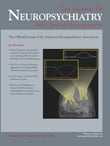Schizophrenia-Like Psychosis and Dysfunction of the Right-Dominant Temporoparietal Lobe in Early-Onset Alzheimer’s Disease
To the Editor: Psychoses such as delusions and hallucinations are commonly observed in Alzheimer’s disease. Previous studies suggest that dysfunction of the frontal lobe and the right hemisphere is associated with psychoses in Alzheimer’s disease. 1 However, the results of previous studies have been inconsistent. This is partly because different types of psychoses are associated with discrete neurological pathophysiologies.
Herein, we report a case in which an early-onset Alzheimer’s disease patient showed schizophrenia-like psychoses and decreased regional cerebral blood flow (rCBF) in the right-dominant temporoparietal lobe.
Case Report
Our patient was a 65-year-old right-handed woman. In August 2003, her family noticed her mild memory disturbance, and she developed delusions that someone intruded into her house, always watched her, and stole her bankbook. In March 2005, she developed auditory hallucinations that someone told her bad things. She also insisted that someone let snakes loose in her house and that someone hid himself under the stool and watched her. She was first diagnosed with schizophrenia and prescribed risperidone. At the next visit, the Mini-Mental Status Examination was administered and she scored 21/30. MRI showed mild diffuse brain atrophy, and SPECT showed right-dominant decreased rCBF in the temporoparietal lobe. Considering these results, her diagnosis was changed to early-onset Alzheimer’s disease. Donepezil was prescribed, and her psychoses were improved.
Discussion
We reported a case with schizophrenia-like psychoses but without psychiatric histories, conscious disturbances, or medical conditions known to cause psychoses. The medical histories and results of examinations met the National Institute of Neurological and Communicative Disorders and Stroke and the Alzheimer’s Disease and Related Disorders Association (NINCDS-ADRDA) criteria for probable early-onset Alzheimer’s disease. We also previously reported two early-onset cases with schizophrenia-like psychoses. 2 , 3 In all three cases, we found right-dominant decreased rCBF in the temporoparietal lobe in SPECT.
It has been suggested that different types of delusions in Alzheimer’s disease are associated with discrete neurological pathophysiologies. For example, previous studies demonstrated that delusions of theft were associated with the right medial posterior parietal lobe in late-onset Alzheimer’s disease. 4 In contrast, in our cases, patients with early-onset Alzheimer’s disease presented with schizophrenia-like psychoses and right-dominant temporoparietal dysfunction. These cases and studies suggest that there may be distinct neural substrates for early- and late-onset Alzheimer’s disease, respectively.
Regarding the right temporoparietal region, some studies reported that it was associated with false belief reasoning. 5 We suggest that dysfunction of the right-dominant temporoparietal lobe might cause misperception of external information and in turn cause schizophrenia-like psychoses.
In our cases, it was difficult to make a diagnosis of Alzheimer’s disease because the psychoses were similar to those in schizophrenia, such as symptoms including auditory hallucinations. Antipsychotics may be used if patients are diagnosed with schizophrenia. However, antipsychotics increase mortality, and donepezil is effective in psychoses in Alzheimer’s disease. Therefore, when we examine presenile patients with psychoses, we should consider the possibility of Alzheimer’s disease and examine the cognitive function and neuroimaging.
1. Nakano S, Yamashita F, Matsuda H, et al: Relationship between delusions and regional cerebral blood flow in Alzheimer’s disease. Dement Geriatr Cogn Disord 2006; 21:16–21Google Scholar
2. Kitabayashi Y, Ueda H, Shibata K, et al: A patient of presenile dementia with psychotic symptoms who manifested disconstruction and memory disturbance. Seishin Igaku 2004; 46:925–931 (Japanese)Google Scholar
3. Kitabayashi Y, Ueda H, Matsumoto R, et al: A patient of presenile dementia with right hemispheric brain atrophy who manifested psychotic symptoms. Rounen Seishin Igaku Zasshi 2004; 15:1393–1399 (Japanese)Google Scholar
4. Fukuhara R, Ikeda M, Nebu A, et al: Alteration of rCBF in Alzheimer’s disease patients with delusions of theft. Neuroreport 2001; 12:2473–2476Google Scholar
5. Sommer M, Dohnel K, Sodian B, et al: Neural correlates of true and false belief reasoning. Neuroimage 2007; 35:1378–1384Google Scholar



